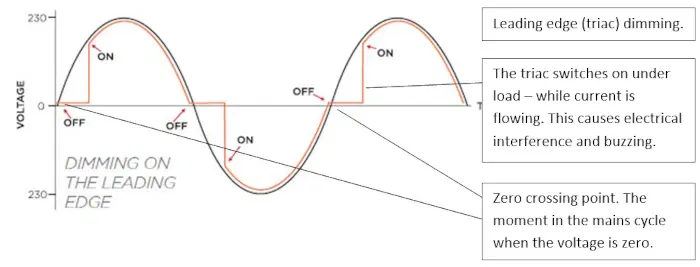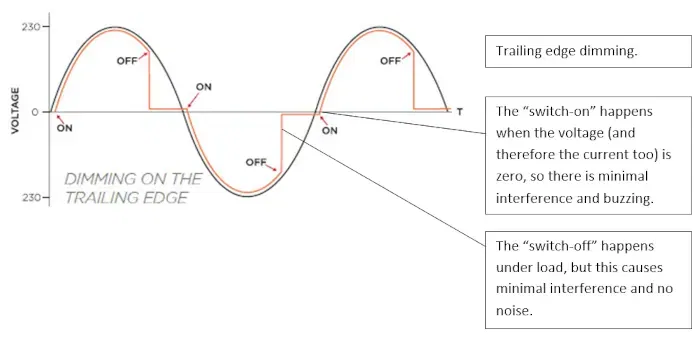
We have at one time or another needed to adjust the volume of a stereo system or any other sound system, or audio player. In essence you can either increase the volume or decrease depending on your comfort levels or any other need. LED dimming works in a similar manner, in that you can either increase or decrease the brightness of a light source. We refer to this as “Dimming”. Both LED lights and traditional incandescent lights can be dimmed. However, LED light dimming differs in inherent complexity compared to dimming incandescent bulbs.
Dimming incandescent bulbs simply involves reducing voltage to a resistive filament. For the case of LED lights, this process is more complex. LEDs are semiconductor devices that require a precise current to operate efficiently. This means that dimming LEDs involves controlling the power delivered to the LED Driver, which is the electronic component that converts the mains AC supply to the low-voltage DC power required by the LEDs.
How LED Dimming Works:
The LED Driver: An LED driver is an electrical component that converts the 240V AC mains input to a low voltage DC output required by LED chips. When it comes to LED dimming, we need a driver that also supports dimming. At its core, LED dimming involves the LED driver regulating the amount of electrical energy reaching the LEDs. This regulation can happen in two primary ways, which are largely internal to the driver:
Pulse Width Modulation (PWM):
This is the most common and often preferred method for LED dimming. An LED driver that dims by using PWM switches the power to the LEDs on and off at a very high frequency, usually in the range of 100Hz to 2kHz. The longer the “on” pulses and the shorter the “off” pulses, the brighter the LEDs will appear to be, and vice versa. Provided this takes place at a frequency greater than about 200Hz, any flickering will not be visible to the human eye and the brain will average the perceived level of brightness, like how the fps (frames per second) works with movies, so we see a continuous picture instead of separate images. The problem with PWM might arise where PWM frequency is too low: some sensitive individuals or cameras might perceive flicker. However, modern drivers use sufficiently high frequencies to minimize this.
Analog Dimming (AM) / Constant Current Reduction (CCR):
Here the driver simply increases or decreases the output current to the LEDs. The risk of flicker is eliminated, but some LEDs change colour slightly if their current is altered, especially at low levels, in other words a slight shift in the color temperature (CCT).
A single LED driver can use a combination of both PWM and AM.
Dimming Technologies:
We have three major types of dimming technologies currently in use: Phase-Cut Dimming (TRIAC Dimming), 0-10V dimming and DALI (Digital Addressable Lighting Interface).
Phase-Cut Dimming (TRIAC Dimming): All phase-cutting dimmers work by switching the AC mains supply to the LED lamp on and off twice in every mains cycle. This has the effect of reducing the flow of electrical energy to the LED lamp or fixture, so reducing its light output. Generally, the later a TRIAC turns ON, the dimmer the light becomes, because the lamp will receive less energy. There are two types of phase-cutting dimmers:
Leading edge phase-cutting dimmers (also known as TRIAC dimmers or rising edge dimmers). These work by switching the current off at the zero-crossing point (see diagram below) and on again later in the same mains cycle. The amount of energy flowing to the LEDs depends on the duration of the “off” period. The longer the off period the dimmer the LEDs will appear to be.

Trailing edge phase-cutting dimmers. These work by switching the current on at the zero crossing point (see diagram below) and off later in the mains cycle. Usually this is done with an electronic component called an isolated gate bipolar transistor (IGBT). The amount of energy flowing to the LEDs depends on the duration of the “off” period. The longer the off period, the dimmer the LEDs will appear to be.

DALI (Digital Addressable Lighting Interface): This is a 2-way communications protocol that is used to provide control over, and communication between, the components in a lighting system. The core of DALI is a bus – a pair of wires that carries digital control signals from input devices (such as sensors), to an application controller. The application controller applies the rules with which it has been programmed to generate outgoing signals to devices such as LED drivers. In essence, DALI provides addressable (meaning we can assign a separated address to each DALI device) devices which run a scalable and flexible lighting network.
Since each DALI device can be assigned a unique address, we can send either an individual control message to a device or a broadcast message to all devices. Furthermore, the DALI devices can also be programmed to operate in groups. This provides excellent flexibility since the lighting systems can be reconfigured by software reprogramming, without the need to change the wiring. Different lighting functions and moods can be achieved in different rooms or areas of a building, and then easily adjusted and optimized. The digital nature of DALI allows two-way communication between devices, so that a device can report a failure, or answer a query about its status or other information.

Lighting Control Strategies
To reach the goal of connected smart lighting, i.e. providing the right quantity and quality of light at the right location and the right moment for minimum energy consumption and minimum operating costs, the following lighting control strategies can be distinguished:
- Time scheduling: automatic switching on and off at predefined times
- Personal control: to adapt the lighting to the actual task and the visual capabilities and age of the actual person
- Daylight harvesting: to link the electric lighting to the daylight amount present at a workplace
- Occupancy sensing: to link the electric lighting to the actual presence of persons
- Constant light control: keeping the light output of a luminaire constant over its life by compensating for lumen depreciation
- Dynamic lighting scenarios: predefined dynamic lighting level and color for health and alertness effects (human-centric lighting)
- Daylight glare control: to reduce glare (and heating) of daylight by adjusting
blinds automatically or manually - Scene setting: predefined scenarios to provide different atmospheres (for example for shops and theatres)
- Tuning: dimming down over-specified lighting to the required lighting level
- Load shedding: automatic temporary reduction of lighting to ensure electricity
supply to more critical systems
Dimmers come in 2 primary varieties: “Trailing Edge” and “Leading Edge.”
Leading-edge dimmers are more effective with conventional incandescent and halogen light bulbs, whereas trailing-edge dimmers are most effective with LED light bulbs.
Do the math – To find out how many LED light bulbs your dimmer switch can support, divide the minimum and maximum load of the dimmer by 10.
For example:
Dimmer is rated 100W-400W
Dimmer Min. Load: 100W / 10 = 10W
Dimmer Max. Load: 400W / 10 = 40W
This then means that when this dimmer is used in conjunction with LED light bulbs, the load must be between 10W – 40W.
Then, add up the combined wattages of the LED light bulbs to find out how many can be supported by this dimmer.
Note: The total wattage of the LED light bulbs on the circuit MUST exceed that of the calculated minimum load of your dimmer.





